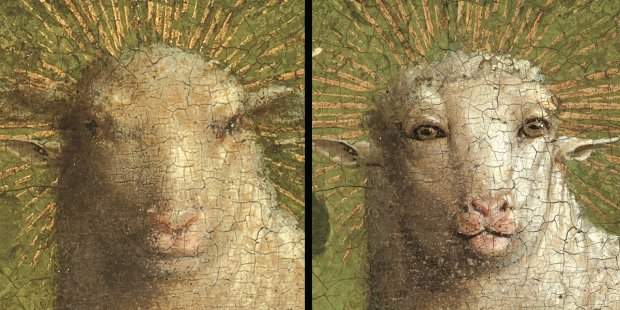This is what the real muzzle of van Eyck's Mystic Lamb looked like. Restoration reveals an almost human-like appearance
The restoration of the Polyptych of the Mystical Lamb, the masterpiece by Hubert (? - Ghent, 1426) and Jan van Eyck (Maaseik, c. 1390 - Bruges, 1441) kept in St. Bavon’s Cathedral in Ghent, where most of the compartments will return, work finished, in the spring of this year (while from February 1 it will be possible to visit, also in Ghent, the largest exhibition ever dedicated to the artist), is nearing completion. And there is turmoil over the most puzzling discovery to have emerged from the intervention, namely the real snout of the lamb painted in 1432 by the van Eyck brothers: the animal had been repainted around 1550, and for centuries no one had been able to observe the lamb as depicted by Jan and Hubert van Eyck. And what has been discovered under the repainting is an almost human (or cartoonish according to others) appearance, which frontally clashes with the image of the lamb as we had known it until now.
According to Hélène Dubois, the art historian in charge of the restoration project, conducted by KIK-IRPA (the Royal Institute for Cultural Heritage of Belgium), the lamb probably had that appearance in order to look at the faithful more intensely and thus inspire greater devotion. It should not be forgotten, after all, that the lamb is also a symbol of Christ. Yet, that stare so fixed perhaps disturbed the sixteenth-century public, so much so that they had to proceed to cover it up by giving the lamb a more natural appearance, according to the taste of the time. Again Dubois, in an interview with The Art Newspaper, revealed that discovering the lamb’s true appearance was “a shock for everyone.”
The intervention was carried out in a careful and highly professional manner: the goal was to remove the extensive repainting and non-original varnishes applied over the centuries in order to restore full legibility to the work and thus regain its original appearance. KIK-IRPA technicians removed the repainting “centimeter by centimeter,” reads a note, “with the use of scalpels and stereomicroscopes.” The consequence is that “there are no words to express the result: freed from thick layers of yellow paint and coarse repainting, van Eyck’s sublime virtuosity can now be abundantly rediscovered. In a naturalistic style that transcends reality, we can see marvelous three-dimensional lighting effects, a display of materials that verges on trompe-l’oeil, and a level of individual characterization for all the characters, animals and plants that testifies to unparalleled minutiae.”
The lamb’s gaze, in fact, was not the only element of the work subsequently repainted. Restorers estimate that nearly 70 percent of the surface was covered in 1550. And it will surely come as a surprise to all who will see it back in place in St. Bavon Cathedral in a few months.
Pictured: on the left is the snout of the lamb with the 1550s repainting; on the right is the one painted by the van Eycks, discovered as a result of the restoration.
 |
| This is what the real muzzle of van Eyck's Mystic Lamb looked like. Restoration reveals an almost human-like appearance |
Warning: the translation into English of the original Italian article was created using automatic tools. We undertake to review all articles, but we do not guarantee the total absence of inaccuracies in the translation due to the program. You can find the original by clicking on the ITA button. If you find any mistake,please contact us.




























